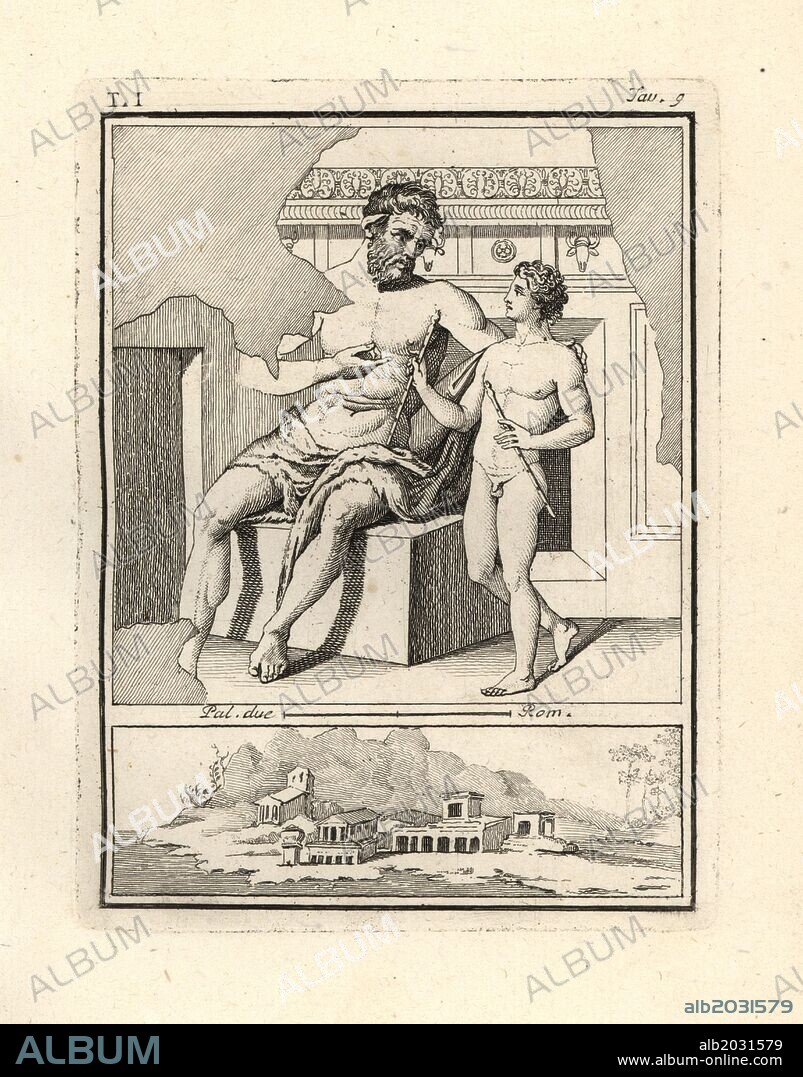alb2031579
The satyr Marsyas sitting on a stone teaching the boy Olympus to play the Tibia or flute, the same subject as rendered by the famous Greek artist Polygnotus. Vignette below shows a Roman villa. Copperplate engraved by Tommaso Piroli from his own "Antichita di Ercolano" (Antiquities of Herculaneum), Rome, 1789. Italian artist and engraver Piroli (1752-1824) published six volumes between 1789 and 1807 documenting the murals and bronzes found in Heraculaneum and Pompeii.

|
Ajouter à une autre Lightbox |
|
Ajouter à une autre Lightbox |



Avez-vous déjà un compte? S'identifier
Vous n'avez pas de compte ? S'inscrire
Acheter cette image.
Sélectionnez l'usage:

Légende:
Voir la traduction automatique
The satyr Marsyas sitting on a stone teaching the boy Olympus to play the Tibia or flute, the same subject as rendered by the famous Greek artist Polygnotus. Vignette below shows a Roman villa. Copperplate engraved by Tommaso Piroli from his own "Antichita di Ercolano" (Antiquities of Herculaneum), Rome, 1789. Italian artist and engraver Piroli (1752-1824) published six volumes between 1789 and 1807 documenting the murals and bronzes found in Heraculaneum and Pompeii.
Crédit:
Album / Florilegius
Autorisations:
Modèle: Non - Propriété: Non
Questions sur les droits?
Questions sur les droits?
Taille de l'image:
4592 x 5853 px | 76.9 MB
Taille d'impression:
38.9 x 49.6 cm | 15.3 x 19.5 in (300 dpi)
Mots clés:
ANTIQUITE • ANTIQUITÉS • ART (CATÉGORIE) • ART ROMAIN • ART • ARTISTE • ARTISTEL • ARTSTE • BASTILLE 1789 • BRONZE • BRONZES • CHANSONS • CHANT • CISELEUR • COURS • CULTURE • DESSIN MURAL • ÉCOLES • EDUCATION ECOLE • EDUCATION • ÉDUQUER • ENSEIGNANT • ENSEIGNEMENT • EPOQUE ROMAINE • FLUTE • FLUTE, INSTR. MUS • FORMATION • FRAVURE • FRESQUE • FRESQUES • GRAVURE • INSTITUTEURS • INSTR. MUS. FLUTE • INSTRUCTION (ENSEIGNEMENT) • INSTRUCTION • ITALIE POMPEI • ITALIEN • ITALIENNE • JOUER DE LA FLUTE • MAITRES ECOLE • MANOIR • MATERIAU BRONZE • MURAL • MUSIQUE • MUSIQUE: CHANSONS • MUSISQUE • PEDAGOGIE • PEINTURES MURALES • PIERRE • PIPEAU • POMPEI • POMPEI, ITALIE • PROFESSEUR • REVOLUTION FRANCAISE (1789-99) • REVOLUTION FRANCAISE 1789 • ROC • ROCHE • ROCHER • ROMAIN • ROME • SCULPTURE • SCULPTURES • SITE ARCHEOL.: POMPEI • TABLEAU MURAL • TECHNIQUE: FRESQUES • TECHNIQUE: SCULPTURE • VILLA
 Pinterest
Pinterest Twitter
Twitter Facebook
Facebook Copier le lien
Copier le lien Email
Email
